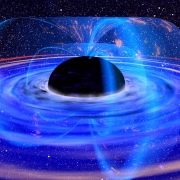Friday 5th January 2024 Decoding the biographies of binary black holes with gravitational waves
Dr Isobel Romero-Shaw
Friday 5th January 2024 7.30 pm in the BRLSI, can be attended either in the BRLSI or remotely on Zoom
The image is a still from a video simulation of merging balck holes © NASA’s Goddard Space Flight Center
Gravitational waves — ripples in the space-time fabric of the Universe — were predicted by Albert Einstein in 1916. After 100 years of advancements in technology and theory, in 2015, the seminal first detection was made. That first signal came from two black holes, each 30 times more massive than the Sun, elegantly spiralling around each other before crashing together. That signal heralded a new era of gravitational-wave astrophysics, and almost 100 gravitational wave signals have been detected in the subsequent eight years. Yet even with this abundance of detections, there is one big unanswered question in gravitational-wave astrophysics: how do merging binary black holes form? Do the black holes live long lives in each other’s company, or meet only shortly before they merge? In this talk, we will explore the different possible formation channels for binary black holes. We will observe gravitational waves, and draw out details that contain whispers of the biographies of the binaries that produced them. Finally, we will review the most recent results as to the origins of our mergers, and look towards the data-rich future of gravitational-wave astrophysics.
Isobel is a postdoctoral research fellow at the University of Cambridge, where she studies gravitational waves from the collisions of black holes (and sometimes neutron stars). Previously, Isobel did her PhD at Monash University in Melbourne, Australia, and has her MSci in Physics from the University of Birmingham.
Recording available here.










